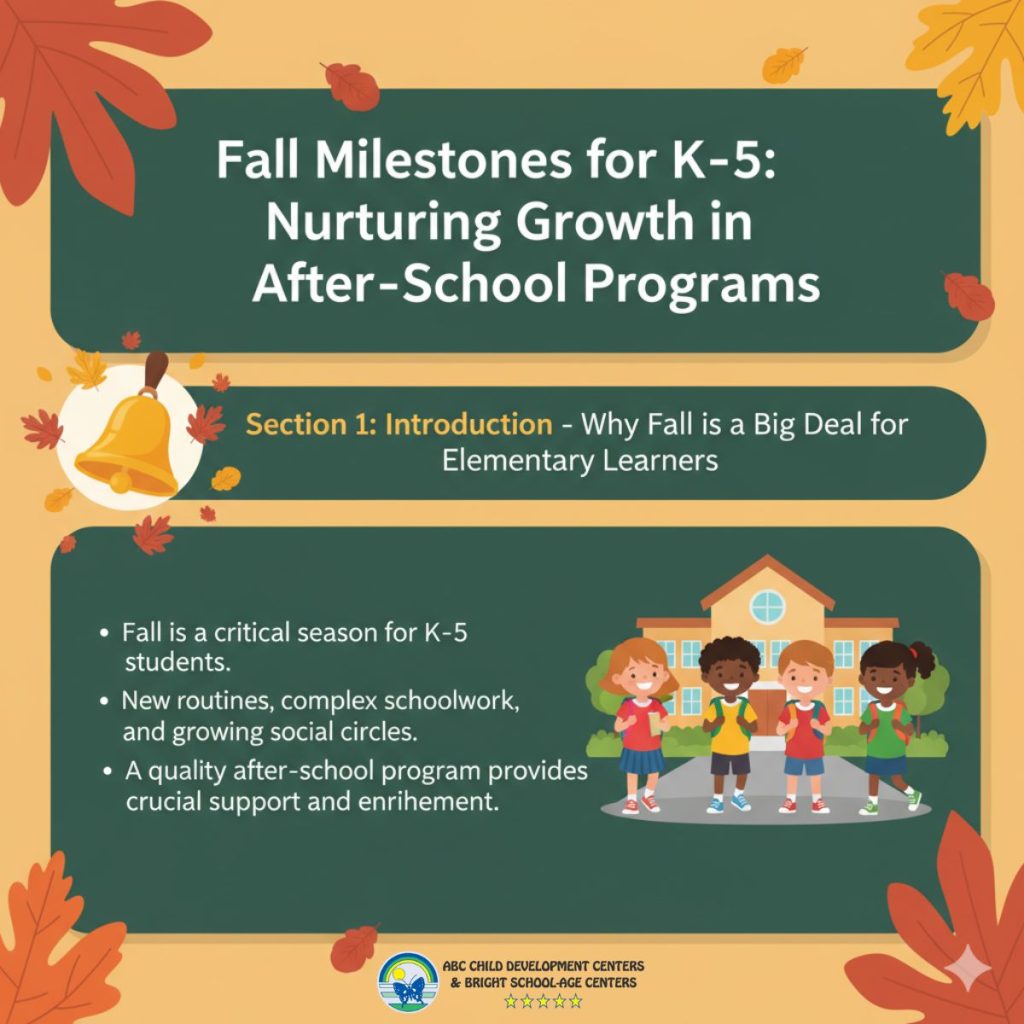As the school year hits its stride and the scent of pumpkin spice fills the air, how can you ensure your child (in grades K-5) continues to grow, explore, and thrive even after the school bell rings?
Fall is a critical time for elementary students; not just for adapting to new classrooms and routines, but for solidifying important social, academic, and executive functioning skills. In this post, we’ll cover key developmental milestones to watch for this season, offer fall-themed activities that support growth, and explain how a quality after-school program is essential for meeting these needs.
A structured and enriching after-school program provides the ideal environment for students in grades K-5 to build essential skills like independence, social competence, and critical thinking, perfectly complementing their classroom learning throughout the autumn season.
Why Fall Is a Big Deal for Elementary Learners

Autumn marks a time of significant transition and deeper engagement for school-age children. They are expected to manage more complex schoolwork, navigate larger social groups, and take greater responsibility for their time. The cooler temperatures and natural changes of fall offer engaging, real-world contexts for learning that go far beyond a textbook.
At Bright School-Age Centers, our programs are specifically designed for students in grades K-5. We provide a blend of structured homework support and engaging enrichment activities that reinforce classroom concepts while nurturing the whole child. Our approach aligns with best practices for after-school care, focusing on developmental stages for this age group.
Milestones to Expect in Fall (Grades K-5)
Elementary school is a period of explosive growth in cognitive, social-emotional, and executive functioning skills. Knowing what to expect helps you partner with your child’s school and their after-school program to support their success.
1. Cognitive and Academic Milestones
- Kindergarten: Showing increased interest in reading, starting to grasp basic math concepts, and demonstrating sustained focus on tasks.
- Grades 1-3: Reading more fluently, engaging in simple problem-solving, and managing multi-step homework assignments.
- Grades 4-5: Demonstrating critical thinking, organizing complex information for reports, and using logic to solve abstract problems.
Fall Activity Tip: Our programs use fall themes for STEM activities. For example, building a miniature “pumpkin launcher” (catapult) or tracking temperature changes helps them apply math and science principles outside of school.
2. Social and Emotional Growth
- Cooperative Play: Moving from playing next to others to actively working with them in groups.
- Empathy: Becoming better at recognizing and responding to the feelings of peers.
- Conflict Resolution: Learning to negotiate, compromise, and resolve disagreements with minimal adult intervention.
Fall Activity Tip: Planning a “Harvest Festival” or group community project encourages teamwork and negotiation. Deciding on roles, sharing materials, and celebrating the result are powerful lessons in social skills.
3. Executive Functioning Skills (Self-Management)
Executive functions are the mental skills that help children get things done. Fall is when these skills are put to the test:
- Organization: Keeping track of books, papers, and homework.
- Time Management: Estimating how long a task will take and sticking to a schedule.
- Working Memory: Remembering multi-step instructions without constant reminders.
Program Support Tip: Our dedicated homework assistance block teaches children how to break down assignments, prioritize tasks, and manage their time effectively, turning good habits into consistent skills.
Why Quality After-School Care is Crucial for Development
A quality after-school program is not just childcare; it’s a deliberate extension of the school day designed to address the unique developmental needs of K-5 students.
- Structured Downtime: We offer supervised time for relaxation and play, ensuring children burn energy and de-stress after a full school day.
- Academic Reinforcement: Immediate homework help and quiet spaces for reading prevent academic gaps from forming.
- Skill Enrichment: Our planned activities focus on areas often cut from school schedules, such as arts, music, and leadership development.
Developmental Concerns to Discuss
While every school-age child grows at their own pace, consistent struggles with certain skills warrant attention. You may want to discuss these with your child’s teacher or pediatrician if your child consistently:
- Struggles to follow two-step directions appropriate for their age.
- Shows extreme difficulty managing their emotions (frequent, intense tantrums beyond the expected age).
- Consistently avoids or struggles with tasks related to fine motor skills (like handwriting or cutting).
- Has persistent trouble maintaining friendships or understanding social cues.
At Bright School-Age Centers, our trained staff observes and communicates with families about a child’s progress, providing a supportive layer between home and school.
In Summary
Fall provides a critical window for elementary school development, offering challenges in academics, social dynamics, and self-management. By understanding these milestones, you can better support your K-5 child. A quality after-school program acts as a vital partner, providing the structure, support, and enrichment necessary to turn these seasonal transitions into lifelong successes.
Is your child’s after-school time building the skills they need to succeed?
Explore how our programs at Bright School-Age Centers support healthy academic and emotional growth with expert homework assistance, enriching activities, and a focus on essential executive functioning skills.
Learn more about our K-5 After-School Programs or Contact Us to schedule a visit today.
